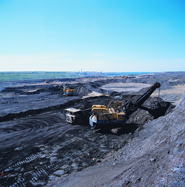22 February 2012
WASHINGTON — It takes a lot of energy to extract heavy, viscous and valuable bitumen from Canada’s oil sands and refine it into gasoline and oil. Companies mine some of the sands with multi-story excavators, separate out the bitumen, and process it further to ease the flow of the crude oil down pipelines. About 1.8 million barrels of oil per day in 2010 were produced from the bitumen of the Canadian oil sands – and the production of those fossil fuels requires the burning of fossil fuels.

Oil sands are excavated at Suncor’s mine in Alberta, Canada. A new study examines the air pollution above the region (CREDIT: Suncor Energy, Inc. Not to be used for commercial purposes.)
In the first look at the overall effect of air pollution from the excavation of oil sands, also called tar sands, in Alberta, Canada, scientists used satellites to measure nitrogen dioxide and sulfur dioxide emitted from the industry. In an area 30 kilometers (19 miles) by 50 kilometers (31 miles) around the mines, they found elevated levels of these pollutants.
“For both gasses, the levels are comparable to what satellites see over a large power plant – or for nitrogen dioxide, comparable to what they see over some medium-sized cities,” said Chris McLinden, a research scientist with Environment Canada, the country’s environmental agency. “It stands out above what’s around it, out in the wilderness, but one thing we wanted to try to do was put it in context.”
The independent report on the levels of these airborne pollutants, which can lead to acid rain if they are in high enough concentrations, is a part of Environment Canada’s efforts to monitor the environmental impact of the oil sands’ surface mines, McLinden said. While some land-based measurements have been taken at particular points by other researchers, and a NASA airplane made another set of localized measurements, no one had calculated the overall extent of the oil sands’ air quality impacts including the giant dump trucks, huge refining facilities where the bitumen is processed, and more.
To do that, McLinden and his colleagues turned to satellite data. Several satellites orbiting Earth detect sunlight that passes through the atmosphere and is reflected back up to the space. Based on the patterns of reflected wavelengths, scientists can calculate the concentration of certain gasses – in particular nitrogen dioxide and sulfur dioxide. It’s a relatively new way to study pollution over small areas, he said.
The study is published today in Geophysical Research Letters, a publication of the American Geophysical Union.
The scientists found that sulfur dioxide amounts peaked over two of the largest mining operations in the Alberta oil sands, with a peak of 1.2×1016 molecules per square centimeter. Nitrogen dioxide concentrations reached about 2.5×10,15 molecules per square centimeter. When researchers looked at the concentrations over the years using older satellite information, they found that the amount of nitrogen dioxide increased about 10 percent each year between 2005 and 2010, keeping pace with the growth of the oil sands industry.
“You’d certainly want to keep monitoring that source if it’s increasing at that rate,” McLinden said. “There are new mines being put in, they’re pulling out more oil.”
It’s important to examine the overall impact of the excavation and processing from the oil sands, said Isobel Simpson, an atmospheric chemist with the University of California at Irvine. She was not involved in this study, but previously participated in the airplane-based research of air quality over the oil sands.
“There are so few independent studies of oil sands,” Simpson said. The new study is something scientists haven’t been able to do before—to “see the big picture and the birds-eye view of the impact of emissions from the oil sands industry,” she said. She called for broader, future studies that would measure additional pollutants and map their extents. With the oil sands industry expanding, she said, the area needs more monitoring.
AGU Contact
Kate Ramsayer, +1 (202) 777-7524, [email protected]
Journalists and public information officers (PIOs) of educational and scientific institutions who have registered with AGU can download a PDF copy of this paper in press by clicking here.
Or, you may order a copy of the final paper by emailing your request to Kate Ramsayer at [email protected]. Please provide your name, the name of your publication, and your phone number.
Neither the paper nor this press release are under embargo.
“Air quality over the Canadian oil sands: A first assessment using satellite observations”
Chris A. McLinden and Vitali E. Fioletov: Environment Canada, Toronto, Canada;
K. F. Boersma: Royal Netherlands Meteorological Institute, De Bilt, The Netherlands and Eindhoven University of Technology, Fluid Dynamics Lab, Eindhoven, Netherlands;
Nickolay A. A. Krotkov: Laboratory for Atmospheric Chemistry and Dynamics, NASA Goddard Space Flight Center, Greenbelt, Maryland, USA;
Chris Sioris: Environment Canada, Toronto, Canada;
Pepijn Veefkind: Eindhoven University of Technology, Fluid Dynamics Lab, Eindhoven, Netherlands and Delft University of Technology, Delft, The Netherlands;
Kai Yang: Laboratory for Atmospheric Chemistry and Dynamics, NASA Goddard Space Flight Center, Greenbelt, Maryland, USA, and Department of Atmospheric and Oceanic Sciences, University of Maryland, College Park, Maryland, USA.
Chris McLinden, Telephone: +1 (416) 739-4594, and Email: [email protected]